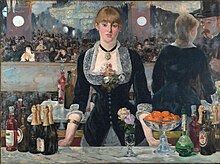Folies Bergère
Les Folies Bergère is a concert hall, variety theater and cabaret in Paris . It's at 32 rue Richer in the 9th arrondissement . It had its greatest popularity between 1890 and the mid-1930s. Today the house mainly houses musicals .
The building was built by the architect Plumeret in the style of an opera house. The facade was renewed in 1929 by Pico in the Art Deco style.
history
On May 2, 1869, the establishment (operettas, comic opera, popular songs) opened under the name "Folies Trévise" (it is located on the corner of the Rue de Trévise ). On September 13, 1872, it was renamed "Folies Bergère" after the Rue Bergère in the neighborhood , because the Duc de Trévise protested against the use of his family name for a variety theater.
Shortly after the start, the owner of the newly opened location remembered one of the national peculiarities of the French variety show: the commitment to eroticism . He created the variety form that should be considered “typically French” in the future, the Grand spectacle . Under the impression of the annual revues, which enjoyed great popularity at some theaters, he staged the first revue adapted to the profession , which premiered on November 30, 1886 and cost the unbelievable sum of 10,000 francs at the time. The programs were filled with many spectacular numbers: strong men, lion tamers, grotesque pantomimes , elephant dressage, abnormality shows and wrestling matches. But even that was not able to lure the audience permanently and regularly into the performances. For this reason, free tickets were organized for the best prostitutes in the city, which entitle them to wander through the foyer halls every two weeks. No offensive offers were allowed, but an encouraging nod of the head was permitted. Paul Derval, director of the Folies Bergère for a long time, wrote in his memoir: “This ingenious system has proven itself very well for a number of years. Every Parisian knew that the ladies in the promenoir were those of easy virtue and that they represented the cream of their profession ... in short, the promenoir of the Folies Bergère was known as the best love market in town. "
The period that followed, roughly from the beginning of the 1920s to the mid-1930s, with its lavish revues, was to be the heyday of French variety shows. The big houses like “ Casino de Paris ”, “ Lido ”, “ Moulin Rouge ” or “Folies Bergère” experienced an enormous upswing thanks to the revue .
Many famous artists have made guest appearances in the Folies Bergère. Among other things, a sensation in 1926 was the “black pearl” Joséphine Baker with her stimulating “banana dance”, in which she only wore a skirt made of bananas in the piece La Folie du Jour (as much as “daily madness / madness of the day”) - otherwise Nothing. In this costume, the dancer often appeared on the stage of the “Folies Bergère” - as the embodiment of the “ Roaring Twenties ”. On October 2, 1925, her great career began at the Théâtre des Champs-Élysées in Paris, where she became world famous almost overnight for her erotic dance, in which she was also almost naked. She quickly became the most successful American entertainer in France, whereas in the USA she suffered from racial prejudice.
painting
Un bar au Folies Bergère , one of the last paintings by Édouard Manet , shows a barmaid from the Folies Bergère. It can be seen in the Courtauld Gallery in London.
Well-known artists in the «Folies Bergère»
It is preceded by the date on which the artists made their debut at the Folies Bergère.
- 1884: Liane de Pougy (1869–1950), dancer
- 1892: Loïe Fuller (1862–1928) dancer
- 1894: La Belle Otéro (1868–1965), dancer and singer
- 1897: Paul Lincke (1866–1946), Kapellmeister , musical director of the Folies Bergère from 1897 to 1899
- 1897: Saharet (1879–1942), Australian can-can dancer
- 1901: Cléo de Mérode (1875–1966), dancer
- 1907: Charles Chaplin (1889–1977), comedian, together with the Fred Karno troupe
- 1909: Maurice Chevalier (1888–1972), singer
- 1911: Mistinguett (1875–1956), singer, met Maurice Chevalier here
- 1911: Stan Laurel (1890-1965), comedian
- 1911 ?: WC Fields (1880–1946), juggler at the time, later film actor
- 1912: Grock (Adrian Wettach, 1880–1959), clown
- 1926: Joséphine Baker (1906–1975), dancer, singer
- 1962: Marlène Charell (* 1944), dancer, singer
- Louisa Baïleche (* 1977), singer and dancer
Web links
- Official website (French)
- History of the Folies Bergère (French)
Coordinates: 48 ° 52 ′ 27 " N , 2 ° 20 ′ 42" E

